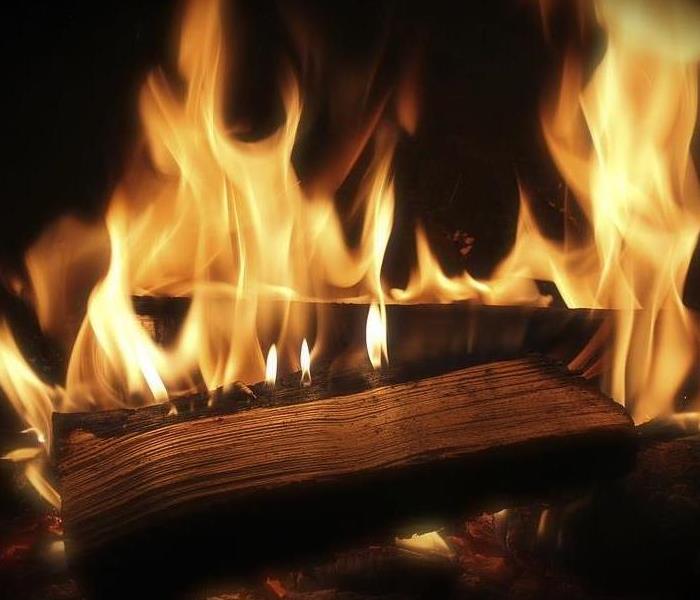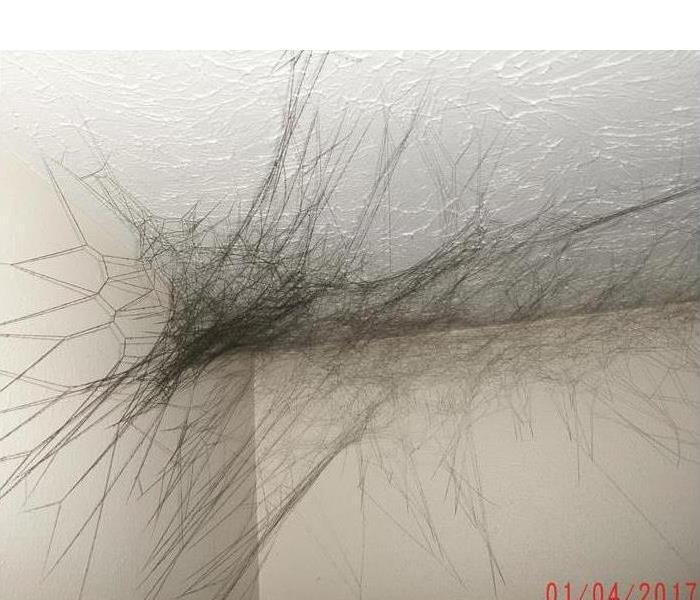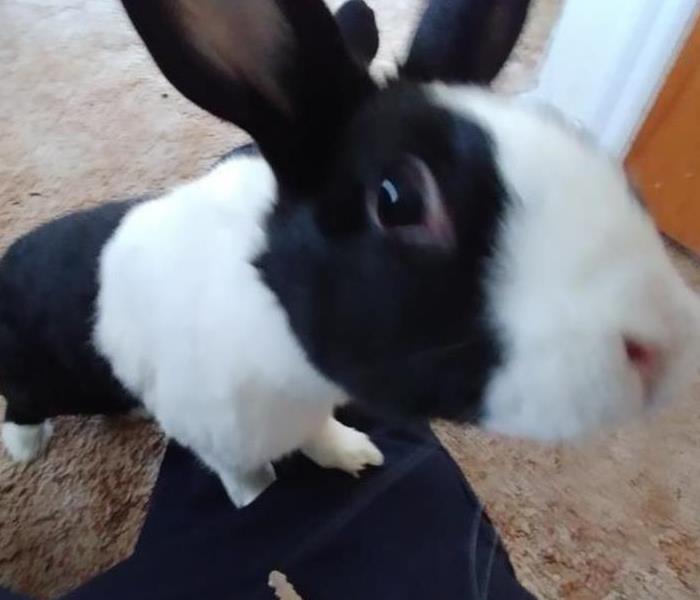Recent Fire Damage Posts
Why Do I Need to Check My Smoke Alarm?
4/6/2023 (Permalink)
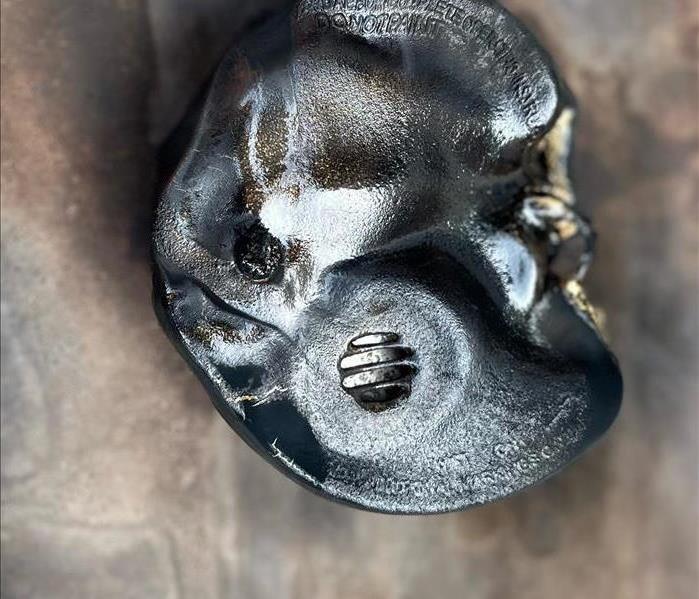 Melted smoke detector from fire
Melted smoke detector from fire
Do I need smoke alarms?
A properly functioning smoke alarm can more than double your family's chances of surviving a fire.
*Install a smoke alarm on every level of your home. In addition, also install a smoke detector in every sleeping area.
*If a family member is hearing impaired, install smoke detector alarms that have a light, flashing light or some other visual aid when the detector is activated.
*Install smoke detector alarms that have a bright light in hallways, stairs and by exit doors to safely and rapidly guide family members out of the structure.
*Test all smoke detector alarms on a monthly basis.
*It is very important to always have fresh batteries in all your smoke detector alarms.
*Change the smoke detector alarm batteries two twice a year. A good rule of thumb to follow: change your clocks, change your smoke detector alarm batteries.
*Smoke detector alarms due have an expiration date! The typical household smoke alarm has a working lifespan of 10 years. If the alarm has CO detector, the lifespan is about 5 to 7 years. A manufacturing date of the detector should be printed on the back plate of the alarm.
*In case of a fire, always have a preplanned / predetermined outside meeting spot for all household members to meet for a headcount.
Fire safety tips from:
SERVPRO of Pottstown / Souderton
Fire Damage
3/28/2023 (Permalink)
 Basement Fire
Basement Fire
The national fire protection association recommends that smoke detectors be installed in every bedroom, and outside of all sleeping quarters and on every level of the house. Smoke alarms work best when they are combined with a fire evacuation route that allows your family or customers a way to safety. Smoke detectors should be on every level of the home including the basement. They should be installed away from the kitchen to prevent false alarms and at least 10 feet from all appliances. Test your detectors at least once per month by using the test button at the bottom of every smoke detector. If it begins to randomly chirp change the batteries immediately. Smoke detectors are only good for ten years after that they need to be replaced. If you sleep with your doors closed at night it can help prevent further damage to the bedrooms, and save lives.
Five Steps to Fire Restoration the Best Practices
6/17/2022 (Permalink)
Five Steps to Fire Restoration the Best Practices
Fire restoration is a process that can take weeks or months to complete. That's why it's important to have the right fire restoration professionals on your side from the beginning of the process. Here are five steps for getting started with fire restoration
- Assess any damages before moving anything, and then contact a professional team to help you remove debris and secure damaged materials.
The first step is to assess the damage caused by the fire. You may be tempted to try and move or clean up damaged items yourself, but this can damage even more of your property. The right restoration professionals know how to move things safely, and they will have the proper equipment.
- Remove smoke damage by cleaning walls, ceilings, furniture, carpets, drapes and other items using specialized products designed for this purpose.
The second step in fire restoration is removing smoke damage. This can be done by using a water-based cleaner to remove soot from walls, ceilings and any other surrounding surfaces. You must also clean all fabrics thoroughly, including furniture, carpets and curtains.
- Clean out all vents and ducts in your home or business as soon as possible after a fire has occurred
The third step in fire restoration is to clean all vents and ducts. If you leave this for too long, it can cause more damage to your property. Cleaning out these areas will ensure that smoke does not continue to spread throughout the home or business.
- Take care of any lingering odors with an air purification system or by opening windows daily to get fresh air
Once you have addressed all smoke damage, the last step in fire restoration is to address any lingering odors. This can be done with an air purification system or by opening windows regularly so that fresh air flows through your home or business for at least a few months after the fire occurred.
- Keep your home or business dry by using fans, dehumidifiers and other systems to reduce humidity
The final step in fire restoration is to keep your home or business dry at all times. This can be done by using fans, dehumidifiers and other equipment that reduces humidity levels in the air. However, you should only use these when necessary since they may damage wood floors if used too often.
You need to hire a professional fire damage restoration company like SERVPRO to help you with the restoration process. We are fully equipped to take care of your fire damage restoration need. A professional company like SERVPRO can assess the damage, remove smoke and other odors, clean vents/ducts, repair any fire or water damage to your home or business, take care of lingering odors with an air purification system or by opening windows for fresh air.
Puff backs
4/14/2022 (Permalink)
Puff backs are a common occurrence in our industry especially over the winter months. Comprised of home heating oil and soot, the amount of damage is staggering. It doesn't look as drastic as a full blown fire, but it is certainly a large cleanup process and one that takes time. We recently completed a job in Pottstown, PA where the homeowner had suffered a puff back from her furnace. The house was built on a slab so the damage carried throughout the entire house. It took a lot of people to coordinate the clean up process. We brought in dry cleaners and specialists who know how to clean art and photographs to remove the soot build up so as not to damage the items any further. Working as a team is the best way to provide the best customer service! Should you need our services, please reach out! We are available 24/7 at 610-327-9644.
Spring Wildfires
4/6/2022 (Permalink)
 Burning yard debris
Burning yard debris
It’s springtime in Pennsylvania, that means its wildfire season. The greatest danger of wildfires occurs during the spring months of March, April, and May, and the autumn months of October and November. Did you know that 99 percent of all wildfires are caused by people? Most frequently they start in someone’s backyard and travel through dead grass and leaves into bordering woodlands.
According to the Pennsylvania Wildfire Statistics there was a total of 1,263 wildfires in the months of March, April, and May of last year (2021) and a total of 1,371 for the whole year. Of course, fires can happen during any month or time of day, destroying woodland and wildlife, threatening human lives, homes, and buildings.
It is very important that you check with your township for burn bans and local ordinances on burning. If you decide to burn any debris, keep a close eye on what you are burning and make sure the fire is out completely when you are done.
Happy Spring from SERVPRO of Pottstown!
resource from: https://www.dcnr.pa.gov/Communities/Wildfire/Pages/default.aspx#:~:text=The%20greatest%20danger%20of%20wildfires,months%20of%20October%20and%20November.
Candles and damage they cause
3/29/2022 (Permalink)
Candles left unattended can cause unimaginable damage. SERVPRO of Pottstown/Souderton provided board up service and a clean out at a home in Pottstown earlier this year. Board up services provide security against break-ins and secondary damage. House fires cause more severe damage than most people realize. When smoke within the house is significant, it will damage personal belongings. When those items are non-salvageable, the items must be inventoried and disposed of. In this particular case, we had to dispose of 90% of the customers possessions. With a crew of 4, this process took a few days. After the cleanout is complete, demolition begins immediately followed by reconstruction. Demolition generally includes removing damaged drywall, floors and ceilings. Reconstruction is the installation of new drywall that is hung, taped, spackled, sanded and painted. New flooring, be it carpet or laminate, and finally paint. Getting the home finished is our prime goal so our customers can have a sense of normalcy again!
Holiday Fire Facts
12/13/2021 (Permalink)
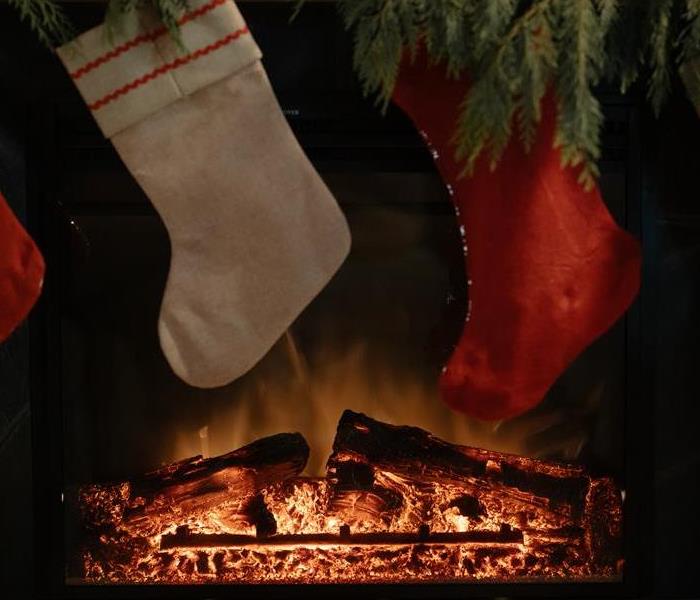 holiday fire dangers
holiday fire dangers
Did you know Christmas trees, holiday decorations, cooking and baking all present potential fire hazards during the winter months? According to the National Fire Protection Association (NFPA), Thanksgiving is the peak day for home cooking fires, followed by Christmas Day and Christmas Eve.
The NFPA statistics underscore the increased risk of fires during the holiday season:
Christmas trees
- Between 2015-2019 , U.S. fire departments responded to an average 160 home fires that started with Christmas trees per year. These fires caused an average of two deaths, 12 injuries, and $10 million in direct property damage annually.
- Electrical distribution or lighting equipment was involved in almost half of home Christmas tree fires. Nearly one in five Christmas tree fires were stared by decorative lights.
- In nearly one-fifth of the Christmas tree fires, some type of heat source, such as a candle or equipment, was too close to the tree.
- One in five Christmas tree fires were intentional. These fires were more common in January.
- Roughly three-quarters of Christmas tree fires occurred in December or January.
- Almost two of every five home Christmas tree fires started in the living room.
Holiday decorations
- U.S. fire departments responded to an estimated average of 790 home structure fires per year that began with decorations, excluding Christmas trees, in 2015-2019. These fires caused an annual average of one civilian fire death, 26 civilian fire injuries and $13 million in direct property damage.
- One in five home decoration fires occurred in December.
- The decoration was too close to a heat source such as a candle or equipment in more than two of every five incidents.
- Year-round, more than one-third of home decoration fires were started by candles. Cooking started 19 percent of decoration fires, 12 percent involved electrical distribution and lighting equipment, heating equipment was involved in 11 percent, 8 percent were intentionally set, and smoking materials started 7 percent.
- Candles caused 45 percent of home decoration fires in December.
Candles
Between 2015-2019, U.S. fire departments responded to an average of 7,400 home fires that were started by candles. These fires caused an average of 90 civilian deaths, 670 civilian injuries and $291 million in direct property damage.
On average, 20 home candle fires were reported each day between 2015-2019.
Three of every five candle fires started when something that could burn, such as furniture, mattresses or bedding, curtains, or decorations, was too close to the candle.
Candle fires peak in December and January with 11 percent of candle fires in each of these months.
Christmas is the peak day for candle fires with roughly 2.5 times the daily average.
Holiday cooking
- Cooking equipment was involved in one of every five (19%) of home decoration fires. This can happen when a decoration is left on or too close to a stove or other cooking equipment.
According to NFPA heating equipment is the second leading cause of US home fire injurie's and third leading cause of home deaths during the winter months. Space heaters being the most involved in home heating fires, accounts for more than two of every five fires (44%).
From everyone here at SERVPRO, we hope everyone has a safe and Happy Holidays!
Christmas decorating
12/1/2021 (Permalink)
Being that today is December 1st, for some people, it is the official kickoff decorating day for the Christmas holiday season! What does this have to do with fire safety? We all want a warm, cozy feeling with lots of bright twinkly lights and a roaring fire to keep away the chill. We want to enjoy a nice cup of hot cocoa or coffee to go with it. But how do you do that and do it safely? There are quite a few ways, actually. Always use battery operated candles in any and all decorations that call for a tealight or votive. If you decorate your mantel, be sure that you are using greens that are not dry where an ember could spark a fire. If you are going to use real candles, save them for the dining room table when you have friends and family over to celebrate with you! We certainly hope you don't need us, but if you do, please call our office at any time 610-327-9644.
Grill Safety
5/28/2021 (Permalink)
Is there anything better than a hot dog or a burger cooked on a grill? We think not. The smell, the taste, the excitement! Warmer weather, longer amounts of daylight, gatherings with friends and families....it just doesn't get any better. Memorial Day weekend is always considered the "Unofficial" start of Summer. It's generally the 1st use of the grill since putting it away in the fall. In order to avoid any issues or even a horrific fire, make sure you properly clean your grill before firing it up for the first time. Be sure your tank has plenty of gas and make sure the grill is at least 10 feet from any structure! Almost 60% of American's use their grills on Memorial Day and while we support that idea, we do worry about the safety of all. We certainly hope you don't need us, but your local SERVPRO franchise is on call and is prepared in case something goes horribly wrong.
The unseen damages from a fire
5/5/2021 (Permalink)
Unfortunately, you have experienced one of the biggest fears of being a property owner, A Fire! A fire not only damages and destroys what the human eye can only see, but also damages the unseen. Such as damages to your property’s HVAC system. When a dwelling fills up with smoke as a result of a fire, this same smoke is pulled into he HVAC system and distributed and circulated throughout the system. Be it smoke from grease, food, plastic, wood, furniture, etc., that smoke get captured inside the HVAC system’s air ducts. The offensive smoke odors will contaminate the ducts as well as attaching odor to any debris or dust within the ducts and filters manifesting into a lingering smell. An offensive smell that will definitely lead to poor air quality within the dwelling. In addition, clogged HVAC air filters will cause the HVAC system to work harder and possibly leading to a shortened system life. Weather the fire is extinguished via water or fire extinguisher, the HVAC system definitely requires a thorough cleaning. For these reasons, it is always mandatory following any type of fire that the HVAC system be inspected and cleaned to remove any dust, grease, debris buildup that will leave a lingering smell if not properly addressed.
Who to call after a fire
5/4/2021 (Permalink)
One of the most devastating damages to a property is the result of a fire. SERVPRO has the capabilities to respond to such emergencies 24 hours a day, 7 days a week and 365 days a year. SERVPRO technicians are always ready to respond to your fire, smoke and soot emergencies. Our highly trained staff will first inspect the fire and smoke damages to your property and belongings. Along with an assessment of the damages, a plan of restoration will be established to move forward to begin the process to restore your property to its original condition. SERVPRO will initially sort, pack and remove your clothing, furniture and all other salvageable belongings for cleaning and self-storage. In addition, we will carefully inspect and document all personal belongings that are damaged beyond repair and carefully document for possible reimbursement through your insurance carrier. SERVPRO will then proceed to remove and clean your property of all damaged building materials to permanently remove all smoke odors.
From minor soot damage from a small kitchen fire to a large structure fire, SERVPRO will coordinate with you and your insurance carrier to reconstruct your property to its pre-fire condition and return your belongings so life can get back to normal as soon as possible.
"Only You Can Prevent Forest Fires"
5/3/2021 (Permalink)
"Only You Can Prevent Forest Fires" is a phrase coined by Smokey the Bear. He's the mascot used to teach young and old about the dangers of Wild fires. Since 1944, Smokey has been the one icon that everyone knows as soon as you see him. His message is clear; only humans can prevent forest fires. When enjoying the great outdoors, we need to remain vigilant that we do not do anything that could accidentally start a forest fire. Make certain that when you go to sleep at night, your fire is completely out and no hot embers can escape and cause destruction. In general, every day life, do not flick cigarettes from cars or trucks. Not only is the littering and illegal, it's also very dangerous.
Annual chimney cleaning
12/9/2020 (Permalink)
According to the CSIA Chimney Safety Institute of America, a clean chimney, generally speaking, will not catch fire. Some of the causes of chimney fires are creosote buildup, unseasoned wood, or a cold chimney. Creosote is an oily substance that will build up on the walls of your chimney over time. It can look yellow, brown, or dark brown to black in color. It can cause a mixture of tar, phenolic compounds, or aromatic hydrocarbons. It is highly flammable and can cause a fire if not treated properly. Some people have reported signs of loud cracking and popping noises, a hot smell, and a dense smoke. You should have your chimney cleaned annually by a certified chimney sweep. The Chimney Safety Institute of America can give you or your loved ones a good referral.
Determining the cause of fire
12/1/2020 (Permalink)
At SERVPRO before restoration begins we will test the area where soot got on the artifact, then we will determine the type of smoke damage occurred. The cleaning procedures will then be based on the information identified during pretesting. Here is some additional information. Wet smoke caused by plastic or rubber, can produce a pungent odor usually a sticky smeary soot results. Smoke webs are more difficult to clean. Now dry smoke from paper or wood is fast burning high temperatures heat rise so smoke also rises. Protein fire residue produced by evaporation of material rather than from fire is virtually invisible, discolors paint and varnishes, and has a extremely foul odor. SERVPRO fire damage restoration services are ready to tackle the problem with equipment and knowledge to bring your property back to it's original state.
Do you know fire?
5/6/2020 (Permalink)
The damage to your property following a fire can often be complicated due to the unique behavior of smoke. There are 2 different types of smoke-wet and dry. As a result there are different types of soot residue. SERVPRO has the training needed in fire cleanup and restoration and they know the different types of smoke and the way they usually behave. You see the way a fire job is handled is related to the result you will obtain when the job is finished. Did you know SERVPRO professionals are trained in the latest way of handling a fire loss? For example hot smoke migrates to cooler areas and upper levels of a structure. Smoke flows around plumbing systems, seeping through the holes used by pipes. SERVPRO has the know-how to make certain your property is like pre loss condition.
Have you checked the smoke detectors
5/6/2020 (Permalink)
The national fire protection association recommends that smoke detectors be installed in every bedroom, outside of all sleeping quarters and on every level of the house. Smoke alarms work best when they are combined with a fire evacuation route that allows your family or customers a way to safety. Smoke detectors should be on every level of the home including the basement. They should be installed away from the kitchen to prevent false alarms and at least 10 feet from all appliances. Test your detectors at least once per month by using the test button at the bottom of every smoke detector. If it begins to randomly chirp change the batteries immediately. Smoke detectors are only good for ten years after that they need to be replaced.
Different types of fires
5/1/2020 (Permalink)
Smoke and soot are very invasive and can penetrate various cavities in your home, causing hidden damage and odor. At SERVPRO our smoke damage expertise and experience allows us to inspectand accurately assess the extent of damage to develop a comprehensive plan of action. Smoke and soot facts are as follows. Hot smoke migrates to cooler areas and upper levels of a structure. Smoke flows around plumbing systems seeping through the holes used in pipes to go from floor floor. The type of smoke may greatly affect the restoraton process.
Different types of smoke, so there are two different types of smoke wet smoke and dry smoke. As a result there are different types of soot residue after a fire. Follow this blog for a second posting.
7 things to help you reduce the risk
5/1/2020 (Permalink)
As the title states there are 7 things you can do to help you reduce the risk of a fire. Keep anything flammable at least 3 feet from the heating equipment. Remember to turn off portable heaters when leaving the room or going to bed. Always use the correct type of fuel specified by the manufacturer for your fuel burning space heaters. Make sure the fireplace has a sturdy screen to stop sparks from flying into the room. Also ashes should be cool before putting them in a metal container. Have heating equipment and chimneys cleaned and inspected every year by a certified professional. Have a qualified professional do any installation of space heating equipment, water heater or central heating equipment according to local codes and manufacturers' instructions.
Thanksgiving house fires
11/20/2019 (Permalink)
Unfortunately, Thanksgiving day is one of the busiest days of the year for fire departments. Believe it or not, the leading cause of house fires in America on Thanksgiving day is deep frying your turkey! You've been up since the wee hours of the morning starting to get all of your sides together and start planning out your day. Or maybe you're watching the Macy's Thanksgiving day parade through New York City. The football game is on and everyone is in a great mood. now comes time for the turkey. Perhaps you have the deep fryer set up in the garage or back patio. When you add the turkey to the heated oil, that spells disaster. You must use caution when doing so! We certainly hope this doesn't affect anyone in our region, but if it does, call us. 610-327-9644
Bonfires
3/14/2019 (Permalink)
Spring is almost here! We're ready to say goodbye to winter and welcome spring with the 1st bonfire of the season. You pick a Saturday night, call some friends and look forward to a relaxing night around a fire. There's some music in the background and everyone is just talking and catching up on life. Everything is going well but have you thought about the dangers? For those with asthma or allergies, breathing in that smoke can be irritating and cause for concern. Try and move yourself out of the path of the smoke and try not to breathe it in. Beware of ash falling and always keep water nearby to properly and safely extinguish the fire. Enjoy yourself and your company but be responsible.
Soot webs
3/6/2019 (Permalink)
After a fire, you are dealing with tons of emotions and lots of questions. How did it start? What do I do now? How am I going to move on from here? Once the fire fire investigators are finished with their portion, the fire marshal usually allows people access to their home, or what's left of it. When you walk back into your home and see tons and tons of spider webs, you wonder to yourself...how did I miss that in my cleaning. the answer is, you didn't. Those aren't spider webs; they're soot webs. Soot webs form when molecules cling to each other like magnets and form a chain. They settle into corners due the cooler temps. We hope you never do, but please call your local SERVPRO franchise at 610-327-9644 if you ever need our services after a fire.
Is it still edible?
2/18/2019 (Permalink)
After a fire, is it safe to eat any of the food that you had stored? Once the fire marshal has determined it is safe for you to enter the premises to inspect the damage, the first thing you want to do is follow a checklist for safety.
Don't use any canned or pre-packaged food or beverages that may have been exposed to heat or contamination.
Do not attempt to shampoo the carpet or upholstered furniture.
Don't send any soft goods like draperies, clothing and bedding to a regular drycleaner. This needs to be done by a professional restoration company.
If you find yourself in this predicament, reach out to your local SERVPRO Franchise professionals at 610-327-9644 or connect with us on Facebook at www.facebook.com/SERVPROofpottstown/souderton
Wires, cords and fires.
2/14/2019 (Permalink)
If you are anything like me, you do not think that a little nick or chunk taken out of any sort of power cord, could cause damage, let alone a full scale fire. I'm very guilty of this and I have just wrapped electrical tape around them instead of replacing the cord itself. but how did the cuts and nicks get there in the first place? Is it from being walked on? Or just general wear and tear of plugging things in and out? For me, the culprit was a 4.5 pound little ball of fluff in the form of an adorable bunny rabbit. He's a cute little bugger but he's destructive so I must constantly keep my eyes on him. I can't begin to tell you how many replacement cords I've purchased. Always keep your eyes on your pets to avoid anything that could resemble a fire hazard.
Washers and dryers and fires.
2/14/2019 (Permalink)
According to the statistics from the National Fire Protection Association from 2010-2014 there was an estimated average of 15,970 home structure fires that involved a washing machine or dryer. Over that 4 year period there were 13 civilian deaths, 444 civilian injuries and $238 million in property damage. Most of the fires involved the dryer itself. When the dust, lint and fibers build up in the lint trap, it can cause a fire. As for the washer, those fires tend to be more related to that actual washer itself. Wire insulation, drive belts and housings or casings seem to be the culprit there. Your local SERVPRO franchise is trained to handle all sorts of fires, so give us a call if you need us. 610-327-9644
Extinguishers; which one to use when
10/19/2018 (Permalink)
We all know that we should keep fire extinguisher's in our homes and businesses...but which ones do we need? It depends on the type of fire. The most common is Class A. This is used to put out most ordinary things like clothing, paper, plastics and wood. Class B is for grease, oil or gasoline. Class C is for appliances, tools or other electrical equipment. Class D is for flammable metals, mostly only found in factories and manufacturing plants. And lastly is Class K. This is for animal fats and vegetable oils and are primarily found in commercial kitchens but are beginning to make their way into residences as well. If you don't have an extinguisher and you find yourself with a grease fire in your kitchen, remember Do Not use Water, throw baking soda on it instead!
DIY nightmare
10/3/2018 (Permalink)
Do It Yourself is all the rage right now. With sites like Pintrest ruling social media, everyone has ideas to make everyone else's lives easier, simpler, or more affordable. Ideas range from making a table out of old skids or pallets to making jewelry. There are cleaning "hacks" and life "hacks" and everything in between. Craft ideas to do with your children during summer break or on a day with no school due to inclement weather. Whatever you're searching for, you can find. The attached picture shows exactly what can go wrong even with adult supervision. The kids were melting Crayons on the stove for a project when it caught fire and you can see the results on the ceiling. We were called for the restoration and cleaning after the fire was put out.
Fire is out, now what?
2/26/2018 (Permalink)
You've had a fire in your home or business and it's been safely put out. What's your next step? Once the fire marshal has determined it is safe for you to enter the premises to inspect the damage, the first thing you want to do is follow a checklist for safety.
Remove valuable items such as documents, old photos, and family heirlooms to a safe, dry place.
Wash both sides of plant leaves to remove soot and debris.
Don't attempt to shampoo carpet or upholstered furniture.
Don't use any canned or pre-packaged food or beverages that may have been exposed to heat or contamination.
Don't send any soft goods like draperies, clothing and bedding to a regular drycleaner. This needs to be done by a professional restoration companies.
If you find yourself in this predicament, reach out to your local SERVPRO Franchise professionals at 610-327-9644 or connect with us on Facebook at www.facebook.com/SERVPROofpottstown/souderton
Valentine's day nightmare
2/14/2018 (Permalink)
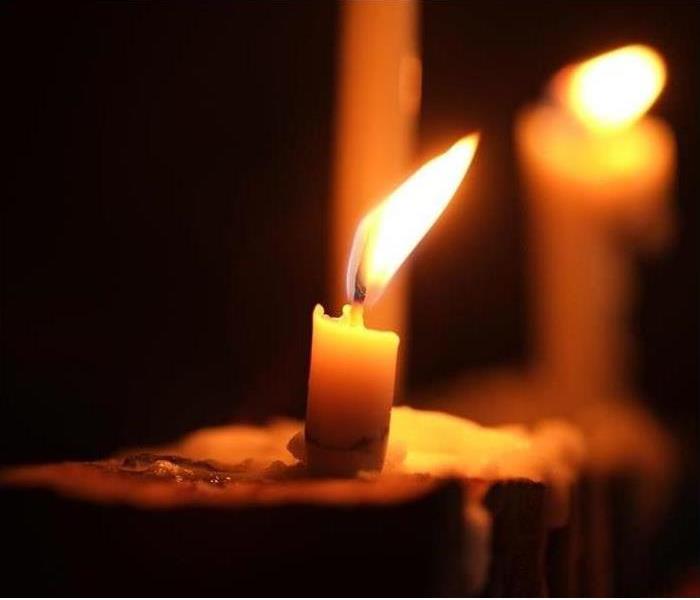
So you want to relax and enjoy your night at home with your significant other. You order a gourmet dinner in, you watch a movie and enjoy few glasses of wine together. You light a few candles to set the mood and the next thing you know, you get called into the other room to check on something. You've left the bedroom where the candles are burning and you start to smell smoke. You rush back into the bedroom and realize that your romantic night has just turned into a nightmare. The cat has jumped up on the nightstand and knocked a candle onto the floor setting the carpet on fire. You all get out safely but now your watching your home burn. According to the NFPA (National Fire Prevention Association) approximately 25 home fires per day are caused by candles. Call your local SERVPRO Franchise at 610-327-9644 to help you get your life back to normal after a devastating fire. Our trained technicians know how to handle fire, soot and water cleanup. You can also find us on Facebook @ www.facebook.com/SERVPROofpottstown/souderton






 24/7 Emergency Service
24/7 Emergency Service




